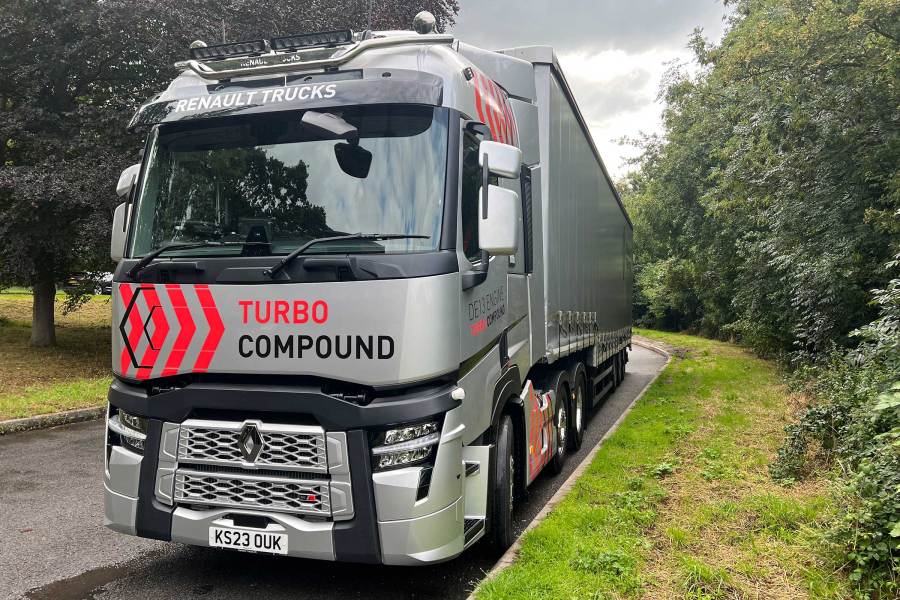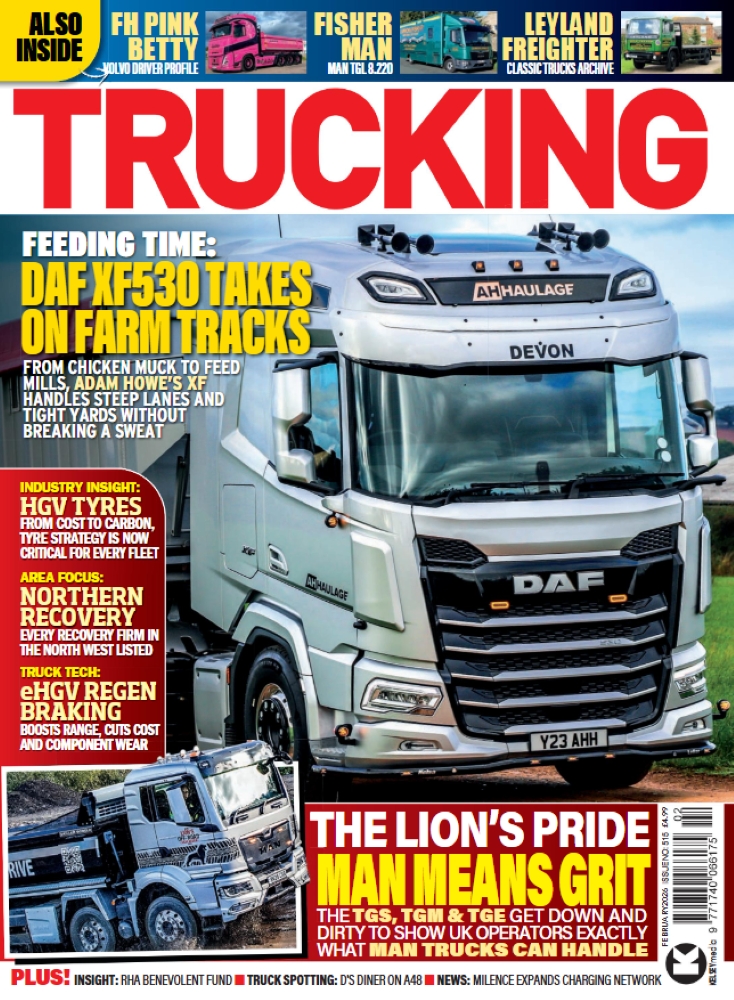For many years Renault has used drivelines from its owners Volvo Trucks – and now it has finally got the new Turbo Compound technology to offer hauliers. Trucking took one for a drive, and a sleepover.
Truck technology never stops, and when you compare vehicles from the 1980s and 1990s with those from now, it’s not only more power that they have, but more torque.
Even trucks from just five years ago are starting to fall behind the latest vehicles on the market both in drivelines and – certainly – cabs and the creature comforts for drivers. Even some of the ‘meh’ models, the supposedly uninspiring ‘boring’ gaffer’s motors are now incredibly well specced.
The market leader DAF has recently overhauled its heavy truck range from top to bottom. Well, nearly to bottom! The LF still soldiers on. Those cabs have already made others look dated and lack in amenities for the driver.
There are, essentially, two types of truck – the aspirational and the practical, with a bit of overlap in the middle. The truly aspirational truck is usually not always the most practical solution. While the most practical truck might not get drivers overly excited.
Renault has, for so long, been stuck in the practical camp over aspirational, which is no bad thing at all, as the former outsells the latter considerably. But then came the Magnum in 1990 and wooed many looking for something a bit different. But it was a bit of a love it or hate it kind of truck. It was replaced in 2013 by the Range T High, and at last Renault had a real flagship. But only in left-hand drive form. Then in 2018, Renault’s owner, Volvo, relented and allowed a RHD Range T High, and suddenly UK operators had a very, very aspirational Renault to consider.
But it’s the ‘bread and butter’ Range T that is the real winner for Renault. It replaced the popular, but unexciting, Premium also in 2013 and has gone on to be evolved and developed, with the 2021 Evolution facelift. And now it has the Turbo Compound engine as an option.
TC was introduced by Volvo in 2017, and has proved to be a real winner. It basically enables more torque to be squeezed out of the existing engine, so in Volvo’s case it makes a 420hp engine pull nearly as good as a 500hp while the 460 is the same as 540 and the 500 is the same as an entry level 16-litre engine.
Volvo has always been, wholly understandably, keen to get its new technology on its own trucks first before letting its little brother Renault have it, but now that has happened and the French manufacturer is offering the Turbo Compound technology in its 12.8-litre DTi, and I went for a drive in a T480TC model.
It’s been quite a while since I drove a standard Range T, and I’d not been behind the wheel of the Evolution model, let alone the Turbo Compound, so I was keen to give the new model a good workout. I’m keen these days, where possible, to get a sleepover in a test truck to get a feel for what they are like for drivers; the people who really count.
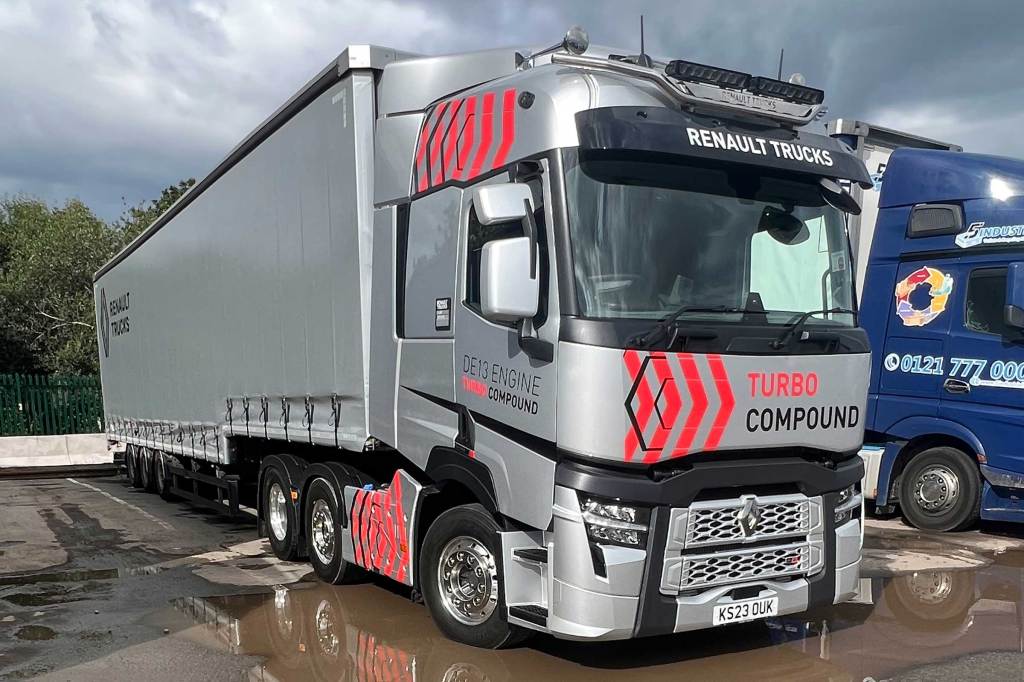
Technical overview
The Range T that I had charge of was the only TC model, the T480 with the larger 12.8-litre straight six DTi engine. This is the middle of its three engines with 483hp between 1,250 and 1,600rpm. The torque is 2,700Nm between 900 and 1,250rpm, that is 300Nm more than the standard 480hp versions and 150Nm more than the 520hp engine which, like the 440, has no TC option.
The alternatives are the non-TC 520 or the 440 models of 512 and 440hp respectively. When you look at those figures a 480TC starts to become a no brainer if you can stomach the extra £3,000 or so it costs. I think it would pay that back in a matter of months let alone over the life of the truck.
The Range T can also be ordered with the 10.8-litre engine in its 430 or 460hp options, the latter an especially popular fleet spec truck where payload is a prime concern. The TC options is not available on this engine, nor is it available on the Volvos with that engine.
The gearbox was the popular AT2812 Optidriver – a version of the I-shift used by Volvo and had 12 gears with ratios from 14.94-1. The rear axle ratio was 2.31:1. The front and midlift axle had 385/55 R22.5 tyres, and the drive axle had 315/70 R22.5s fitted. Alcoa Durabrite aluminium wheels were fitted.
The TC engine uses a compact after-treatment system with a catalytic converter, diesel particulate filter and selective catalytic reduction to allow it to meet Euro 6e emission standards.
On a 3,900mm wheelbase, the truck has a fairly standard 8,000kg front axle, 7,500kg midlife, and an 11,500kg rear drive axle set up. Range Ts can also be specified as 4×2, 6x2s with a small midlife, and 6x2s with a rear tag axle. 6×4 tractors are also available for heavy haulage and muck-away applications. The cab was understandably a high-roof-sleaver, though day- and flat-roof-sleaver sleepers are also options.
The tractor unit weighed in at 8,480kg, not the best in class but not the worst by any imagination so a 28 tonne payload should be achievable with the right trailer.
On the road
The truck was coupled to a tri-axle step-frame curtainsider trailer, which was loaded with about 17 tonnes of concrete blocks, so while not at full weight, the outfit was about 33 tonnes in total – enough to give it a good workout.
The truck performed superbly, and so it should with 480hp on tap and 2,700Nm at your disposal. It pulls away with real ease and there should be no shortage of oomph in your situation.
The build quality appears to be fine, apart from a slight squeak on the steering wheel but there were no rattles or draughts to annoy the driver. There is a fair bit of plastic on display, but as I often say, driving a demo truck is a different ballpark from having a truck to yourself which you can kit out as you see fit in real life – press trucks are always well-specced and immaculate throughout and not full of your clutter so perhaps you just notice the mass of plastic panels that little bit more. But overall there was nothing loose or rattly to annoy me on the move.
The ride quality was good and very smooth and the all-round vision pretty much spot on, and would only really be improved by having digital cameras instead of large wing mirrors.
The steering was good and precise, and the three-stage Optibrake retarder was very effective indeed. The cruise control worked a treat and was easy to manage. Therefore, the comfort while driving was top-notch, and this was a very nice truck indeed.
One annoying feature of Renaults is the gear selector, which won’t go directly from reverse to neutral to forward. The gearshift itself is superb and amongst the best in the business—smooth, quiet, and happens at the right time, but the ability to change between modes seamlessly is still a bit of a pain in the backside on a Renault. Well, I guess there has to be one annoyingly French overcomplication of what should be an easy thing to achieve.
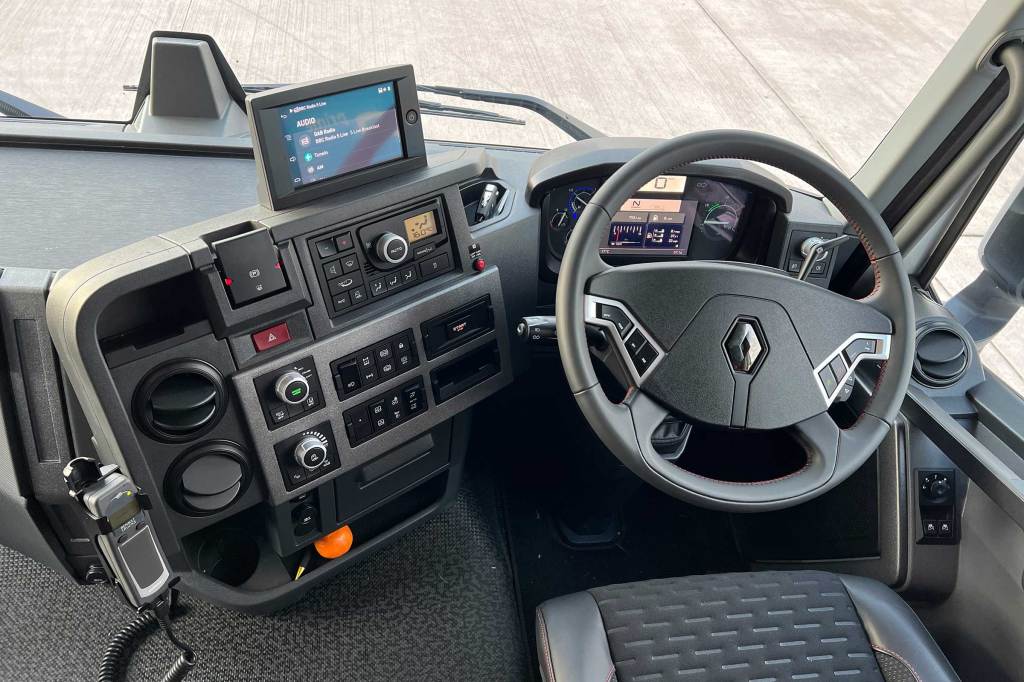
The cab
Getting into the truck is via three steps, and Renault has – like others – recently improved its steering wheel so it can fold flat out of the way making easier entry and exit, especially when carrying bags. That makes the overall ease of entry very good indeed. There are two grab handles and the door opens an impressive 90 degrees.
The dashboard is ok, it’s clear and easy to use, but it is due for replacement for a new digital dash bringing it into line not only with stablemate Volvo, but all other manufacturers which now either have digital dashes or are about to launch them.
The truck used keyless technology – so long as you have the key on you, or in the cab, you can press the start button to fire up the engine, assuming you have your foot on the brake. And then you can get away as it has the electronic parking brake that comes off automatically when you apply the power. It’s actually a good set up when you get used to it.
There are three stalks, on the left is the stalk for indicators, lights, horn and wipers while on the right is the stalk for the gear selection. Then there is a thin stalk on the right for the engine brake, which is three stages.
In the door are buttons for the windows and mirror adjustment. Overall the positioning of the buttons is good. The cruise control is on the steering wheel and is the quirky Renault set up that the plus and minus button is underneath the wheel. That takes a bit of getting used to but actually once you do it actually makes good sense.
The seats were a mix of cloth and leather, being a press demo truck, then they were always going to be near the top end of the market. Armrests are fitted and headrests are incorporated in the seat back. The seats are very comfortable and had a good reclining angle for resting without getting on the bunk.
One area where Renaults lack is storage and cup holders within easy access of the driver around the dash. When I shuffle off this planet, truck manufacturers will be no doubt be relieved my ‘obsession’ with cup holders may be consigned to history, but it is a real bugbear of mine. The Range T has just one accessible cup holder by the dash and it’s not actually all that close to the driver. It’s poorly positioned and there’s not enough of them.
I speak from experience of driving, but a truck needs two decent cup holders close to the driver. One for the morning coffee and one for a bottle of water, juice or pop. And they need to be adjustable cupholders that grip any cup put in them. Not a one size that simply doesn’t fit all.
Likewise a pull-out, or engine hump, tray for paperwork and documents is always useful, and the Range T doesn’t have that; in short there just isn’t enough storage in and around the dash for the nick knacks the driver needs to be close to hand.
There are five grilles for hot or cold air and the cab temperature is easy to adjust to keep it where you want it to be at depending on the conditions and weather.
Renault still uses conventional mirrors in the standard set up of two each side, a kerbside mirror and a cyclops mirror. It has shown a concept truck with digital mirrors – I’m not sure if they were just for show or actual operation – and I feel they can’t be too far away, surely? Let’s hope so!
The truck has two USB-C sockets, which is great if you have that type of cable, but for the [currently] more common USB-B socket, there is only one, and it’s above the windscreen, so not in the best position and essentially unusable while driving. There is a 12V and 24V socket on the dash as well. There is one 12V and two USB-C sockets by the bunk as well.
While storage around the dash is inadequate, the same can’t be said for in the cab itself, with six capacious lockers – three above the windscreen and there above the bunk, which means this is a great truck for long haul and tramping operations. There are also under-bunk storage and outside lockers for the ‘mucky stuff’.
The truck had a fridge, but this was very stiff to open, but given this was a brand new 23-plate truck with next to no mileage on it, I’ll not judge it down on that. There was, however, a rather plasticly clip on bottle holder, which is good if you want a 2-litre bottle of water to hand, but if you don’t, it’s more of a hindrance than a feature. It can, however be detached and removed, as I found out unintentionally. There is also a removable mini bin which is a nice touch. The truck really needs a pull-out table on the passenger side, I’m not sure if that is an option or not?
The front grille was easy to open with just one catch needed to release it. Likewise the side aerodynamic deflector had a catch needed to push them in to gain access to the catwalk and susies.
Overnight
Shocking confession time, I’ve never overnighted in a Renault, so I was pleased to rectify that in this road test. I opted for a quiet lay-by close to Stratford-upon-Avon with a fair distance from the busy A46, although I could hear the passing traffic, which naturally declined as the evening wore on.
The bunk in the Range T is superb, so, so comfortable, and my truck had a mattress topper as well, plus a sort of ‘half a hammock’ which clips up at the top to give you a nice recliner. The curtains are also top notch, they are thick, black and block the light out superbly.
There is a remote control that is on a magnet so is easy to put back in place even in the dark. It has buttons for the lights, heater and so on, but is only at one end of the bunk and really could do with being located in the middle so it’s usable whatever way round you sleep. There are, however, powerful reading lamps at either end, although their buttons are a bit of a stretch to get to!
I didn’t need to use the night heater as it was a perfect night temperature wise, in fact it was a bit hot and sticky to start with but then cooled down. I had a good night’s sleep, which is a bonus for me as someone who only sleeps in a truck very, very occasionally. Nevertheless, I got to sleep well and slept through without any interruptions, in fact the truck in front of me had gone by the time I got up at 0530 and I hadn’t heard it start up to pull away, so that is testament to how well I slept.
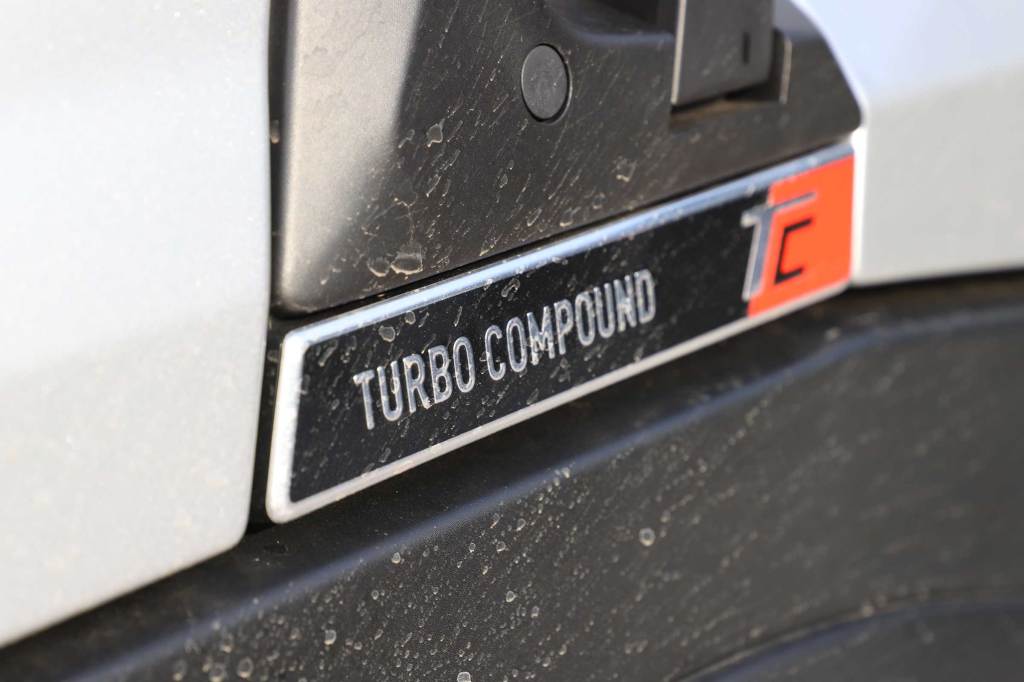
Conclusions
Renault is in a good place at the moment, its product is excellent and offers real value for money especially when compared with the prices of other manufacturers’ wares and of course you get that tried and tested, and much-liked, Volvo driveline. The cab is generally very good, and only let down by the smallest of niggles like cup holders, USB sockets and positioning of some buttons and features.
The T480 TC is an absolutely beast of a truck and needs to be taken seriously by any operator looking at a new 44 tonner. The Range T is a varied platform with lots of choice for hauliers and its cab is superb for drivers.
If there’s not enough room, then there’s a Range T High to sort that deficiency out for you, and that too is a superb truck. Now with the added boost of the Turbo Compound you can have pulling power and decent fuel returns in one truck.
I’ve been seeing, and hearing of, several hauliers that have been reliant on other marques, and in many cases very loyal to them, but are now test driving and ultimately ordering a Renault or two to combat the increased price of lorries these days.
The usual caveats apply, of course, those old chestnuts of having a good dealer and salesman. If you have access to a Renault dealer with a reputation for delivering good back up then this is a truck that you really ought to take very seriously indeed. It has it all – good operating costs, a good cab, a great driveline and a great business proposition.
We like
- Great pulling power
- Superb cab
- Excellent business case
- Very comfortable bunk
- Favourable purchase price
We don’t like
- Inadequate storage around the dash
- Bunk lights poorly positioned
Renault Range T 480 Turbo Compound
- Design GCW: 44,000kg
- Chassis: 3,900mm wheelbase
- Front axle: 8,000kg capacity.
- Rear axle: 11,500kg (drive) 7500kg (midlift), 2.31:1 ratio. 385/55 (non-drive) 315/70 R22.5 (drive) tyres
- Gearbox: Optidrver AT2812 automated 12-speed
- Engine: DTi13 12.8-litre straight six with Turbo Compound, SCR
- Max power: 483 bhp @ 1,250-1,600 rpm
- Max torque: 2,700 Nm @ 900-1,250 rpm
- Cab: High roof sleeper

